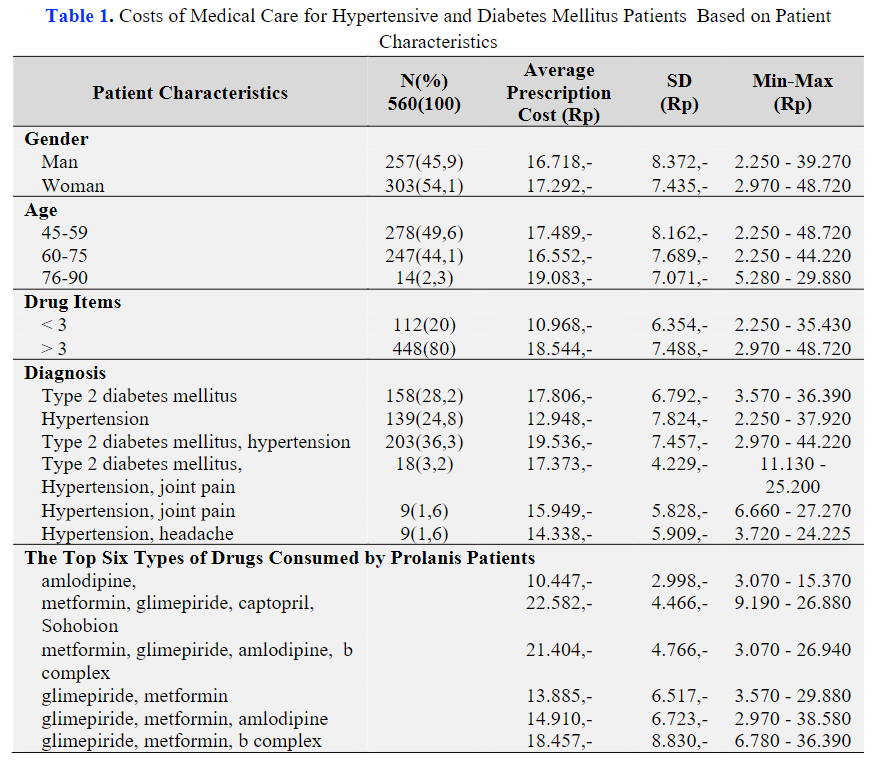Main Article Content
Abstract
Chronic disease is a long-term health condition that requires on-going medical attention, and is classified as a non-communicable disease. The long-term medical treatment for chronic diseases, such as type 2 diabetes mellitus and hypertension is considerably costly. This study aims to determine the real cost and pattern of drug prescribing as well as the factors affecting the real Prescription Cost for hypertension and type 2 diabetes mellitus after the implementation of Indonesian National Health Insurance (JKN) as seen from the practice of Independent Physicial in collaboration with BPJS Kesehatan (Healthcare and Social Security Agency). This is a non-experimental (observational) study. The data were collected using purposive sampling method with 147 medical prescriptions as the research samples for each type of disease from the patient's medical record. Data were analyzed descriptively to determine Prescription Costs and spearman's rho test was used to determine the factors that influence Prescription Costs. The study revealed that the average Prescription Cost for type 2 DM patients was Rp17,806,- and Rp12,946 for hypertensive patients. Factors that affected Prescription Cost were diagnosis (p= 0.026), type of medicine (p= 0.000) and drug items (p= 0.000). This study concludes that patients with diabetes mellitus were treated with the drug prescription pattern of a combination of metformin and glimepiride, while patients with hypertension were provided with amlodipine. The real Prescription Cost is influenced by several factors, including; the patient's diagnosis, the type of drug given and the number of drug items provided to patients.
Keywords
Article Details

This work is licensed under a Creative Commons Attribution-NonCommercial 4.0 International License.
References
- Abror, N. A., Andayani, T. M., & Sulistiawaty, E. (2019). Analisis biaya penyakit Diabetes Melitus sebagai pertimbangan perencanaan pembiayaan kesehatan. Jurnal Farmasi Galenika (Galenika Journal of Pharmacy)(e-Journal), 5(1), 73–83. https://doi.org/10.22487/j24428744.2019.v5.i1.12071
- Al-Maskari, F., El-Sadig, M., & Nagelkerke, N. (2010). Assessment of the direct medical costs of diabetes mellitus and its complications in the United Arab Emirates. BMC Public Health, 10(1), 1–10. https://doi.org/10.1186/1471-2458-10-679
- Almasdy, D., Sari, D. P., Suhatri, S., Darwin, D., & Kurniasih, N. (2015). Evaluasi penggunaan obat antidiabetik pada pasien diabetes melitus tipe-2 di suatu rumah sakit pemerintah kota Padang–Sumatera Barat. Jurnal Sains Farmasi & Klinis, 2(1), 104–110.
- Ariana, R., Sari, C. W. M., & Kurniawan, T. (2019). Perception of Prolanis Participants About Chronic Disease Management Program Activities (PROLANIS) in the Primary Health Service Universitas Padjadjaran. NurseLine Journal, 4(2), 103–113. https://doi.org/10.19184/nlj.v4i2.12687
- Baroroh, F., & Fathonah, S. S. (2017). Biaya medik langsung terapi hipertensi pasien rawat jalan di Rumah Sakit X Yogyakarta. Jurnal Farmasi Sains Dan Praktis, 3(2), 6–13. https://doi.org/10.31603/pharmacy.v3i2.1724
- Bestari, B. K., & Wati, D. N. K. (2016). Penyakit kronis lebih dari satu menimbulkan peningkatan perasaan cemas pada lansia di Kecamatan Cibinong. Jurnal Keperawatan Indonesia, 19(1), 49–54.
- BPJS. (2017). Petunjuk Teknis Pelaksanaan Pembayaran Kapitasi Berbasis Pemenuhan Komitmen Pelayanan Pada Fasilitas Kesehatan Tingkat Pertama. BPJS Kesehatan.
- Erni, S., & Ning, A. W. (2017). Hubungan Lama Menderita Dan Kejadian Komplikasi Dengan Kualitas Hidup Lansia Penderita Diabetes Mellitus Tipe 2. SENASPRO 2017| Seminar Nasional Dan Gelar Produk Available at Http://Research-Report. Umm. Ac. Id/Index. Php/Research-Report/Article/ViewFile/1194/1413.
- Jo, N. (2016). Studi perbandingan obat generik dan obat dengan nama dagang. Jurnal Farmanesia, 3(1), 5–10. http://e-journal.sari-mutiara.ac.id/index.php/2/article/view/21
- Khomarun, K., Nugroho, M. A., & Wahyuni, E. S. (2014). Pengaruh aktivitas fisik jalan pagi terhadap penurunan tekanan darah pada lansia dengan hipertensi stadium I di Posyandu Lansia Desa Makamhaji. Interest: Jurnal Ilmu Kesehatan, 3(2), 166–171. http://jurnal.poltekkes-solo.ac.id/index.php/Int/article/view/97
- Muti, A. F., & Octavia, N. (2018). Kajian Penggunaan Obat Berdasarkan Indikator Peresepan WHO dan Prescribing Errors Di Apotek Naura Medika, Depok. Sainstech Farma, 11(1), 25–30. https://doi.org/10.37277/sfj.v11i1.408
- Setiaji, H., Cahyaningsih, T., Sucipto, E., & Rahmawati, L. (2018). Profil Kesehatan Kabupaten Tegal Tahun 2017. Dinas Kesehatan Kabupaten Tegal.
- Sulistyaningrum, I. H., Kristina, S. A., & Mukti, A. G. (2021). Analysis of Chronic Disease Direct Cost at Public Primary Health Cares in Indonesia. Bangladesh Journal of Medical Science, 20(4), 762–767. https://doi.org/10.3329/bjms.v20i4.54131
- Wahyudi, H. A., Wardhana, M. I., & Sutrisno, A. (2021). Perancangan Buku Infografis sebagai Media Informasi tentang Penyakit-Penyakit Kronis bagi Remaja. JoLLA: Journal of Language, Literature, and Arts, 1(6), 794–807. https://doi.org/10.17977/um064v1i62021p794-807
- Wardani, A. P., Witcahyo, E., & Utami, S. (2018). Efektivitas Biaya Program Pengelolaan Penyakit Kronis (Prolanis) di Puskesmas. HIGEIA (Journal of Public Health Research and Development), 2(4), 622–633. https://doi.org/10.15294/higeia.v2i4.20763
- Yonata, A., & Pratama, A. S. (2016). Hipertensi Sebagai Pencetus Terjadinya Stroke. Majority 5(3), 17-21. https://juke.kedokteran.unila.ac.id/index.php/majority/article/view/1030
